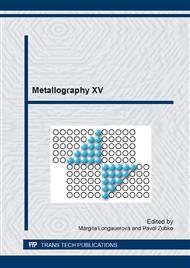[1]
L. Shi, C.F. Sun, P. Gao, F. Zhou, W.M. Liu, Electrodeposition and characterization of Ni-Co-carbon nanotubes composite coatings, Applied Surface Science. 16-17 (2006) 4870-4875.
DOI: 10.1016/j.surfcoat.2005.04.037
Google Scholar
[2]
L. Burzynska, E. Rudnik, The influence of electrolysis parameters on the composition and morphology of Co-Ni alloys, Hydrometallurgy. 2-3 (2000) 133-149.
DOI: 10.1016/s0304-386x(99)00060-2
Google Scholar
[3]
S.S. Abd El-Rehim, A.M. Abd El-Halim, M.M. Osman, Electrodeposition of Sn-Co alloys from gluconate baths, Journal Applied Electrochemistry. 26 (1985) 413-418.
DOI: 10.1007/bf00251326
Google Scholar
[4]
S. Goldbach, Electrodeposition of Ni-Co alloys from sulfamate baths, Journal of Applied Electrochemistry. 30 (2000) 277-284.
Google Scholar
[5]
D. Golodnitsky, Yu. Rosenberg, A. Ulus, Role of anion additives in the electrodeposition of Ni-Co alloy from sulfamate electrolyte, Electrochimistry Acta. 47 (2002) 2707-2714.
DOI: 10.1016/s0013-4686(02)00135-4
Google Scholar
[6]
R. Oriňáková, A. Oriňák, G. Vering, I. Talian, R.M. Smith, H.F. Arlinghaus, Influence of pH on the electrolytic deposition of Ni-Co films, Thin Solid Films. 10 (2008), 3045 – 3050.
DOI: 10.1016/j.tsf.2007.12.081
Google Scholar
[7]
D. Jakubéczyová, M. Kočík, P. Hvizdoš, Application of fractography in assessment of composite layers, Acta Metallurgica Slovaca. 3 (2013) 219-225.
DOI: 10.12776/amsc.v3i0.131
Google Scholar
[8]
G. M. Pharr, W.C. Oliver: Measurement of thin film mechanical properties using nanoindentation, MRS Bulletin (1992).
DOI: 10.1557/s0883769400041634
Google Scholar
[9]
H. Natter, M. Schmelzer, R. Hempelmann, Nanocrastalline nickel and nickel-copper alloys: Synthesis, characterization and thermal stability, Journal of Material Research. 13 (1998), 1186-1197.
DOI: 10.1557/jmr.1998.0169
Google Scholar
[10]
W. J. Safranek, The Properties of Electrodeposited Metals and Alloys. Handbook, 2 sub edition, Amazon. com (1974).
Google Scholar
[11]
N. Fenineche, Effect of electrodeposition parameters on the microstructure and mechanical properties of Co-Ni alloys, Surface and Coating Technology. 1 (1990) 75-81.
DOI: 10.1016/0257-8972(90)90131-u
Google Scholar


